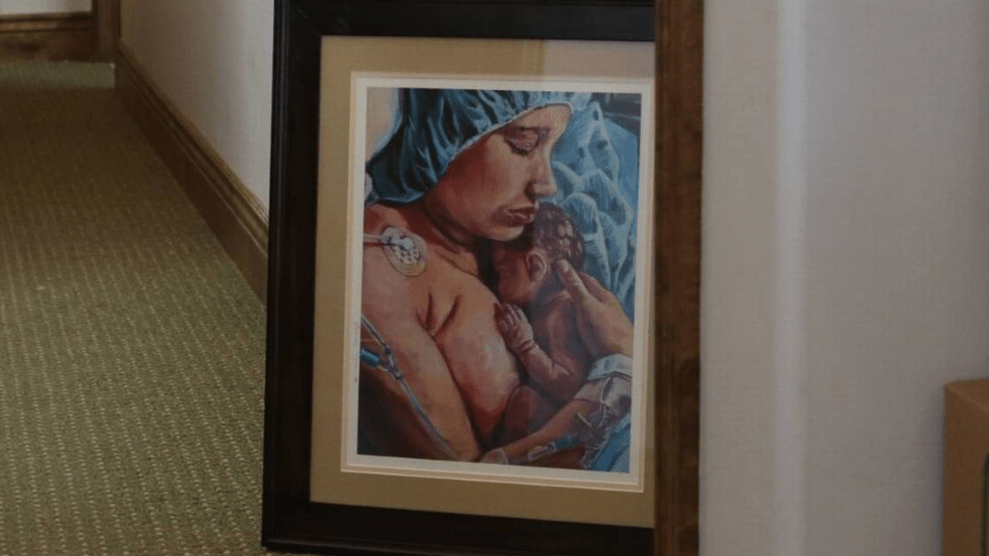Imagine restoring memory to someone with Alzheimer’s, giving a diabetic freedom from insulin injections, or helping a paralyzed person walk again. Such is the promise of embryonic stem cells — or was, until the Bush administration cut off federal funding for labs harvesting new cell lines in August, 2001. As progress in this field depends heavily on
government dollars, the pace of development slowed dramatically. And all, it seemed, because the president felt the need to pander to the religious right, tainting secular science with religious ideology.
Stem cell researcher Dr. Robert Lanza, chief medical officer at Advanced Cell Technology in Massachusetts, tells MSNBC “All the money for this work has dried up … We are lucky to still be in business. Our research has suffered immensely.”
But human ingenuity, especially when allied with human need, has a way of finding a way. And now, university labs that once leaned on government financing have taken to private fundraising and activism to work around federal barriers. Private funding exceeds government dollars for stem cell research but don’t bankroll nearly as many trials as the government could.
Using private money, researchers at Harvard University this week created 17 new colonies of stem cells and announced they would be made freely available to scientists thwarted by a ban on federal funds for such research, doubling the supply of research-ready stem cells in the United States.
Bush capped government-backed stem cell research at 78 pre-existing lines. However, only 15 of those, costing as much as $5,000 each, are currently viable — a supply scientists call paltry for making inroads against complicated diseases.
Pliable, neutral stem cells easily adopt the qualities of a wide range of tissues, making them coveted in cutting-edge experiments. For example, scientists are trying to graft the material into damaged spines to coax nerve tissue back to life, and are implanting stem cells in a diabetic’s pancreas hoping to trigger insulin production.
Yet the president likens stem cell research, which destroys a living human embryo, to murder. Private religious beliefs as well as the influence of the anti-abortion lobby are undoubtedly informing his stance, which is spelled out by Britain’s BioNews:
For Bush, research on these [government-approved] cell lines is permissible because ‘the life-and-death decision has already been made’. He was keen to avoid “crossing a fundamental more line by providing taxpayer funding that would sanction or encourage further destruction of human embryos.”
Bush saw his rule a compromise but critics call it hypocritical and callous.
Kristen Philipkoski of Wired describes the response of the Union of Concerned Scientists, which said the Bush administration:
distorted and suppressed findings that contradicted administration policies, stacked panels with like-minded and underqualified scientists with ties to industry, and eliminated some advisory committees altogether.
Both Democrats and some moderate Republicans are urging Bush to loosen restrictions, and accusations are flying that the president’s hand-picked advisory group leans too far to the right. Some 170 scientists lobbied the president Wednesday after his bioethics advisory council canned pro-stem cell panelists, Elizabeth Blackburn of the University of California and William May of Southern Methodist University, to be replaced by more congenial scientists.
Wired profiles the new picks:
The replacements are Benjamin Carson, director of pediatric neurosurgery at Johns Hopkins University; Peter Lawler, professor of government at Berry College; and Diana Schaub, a political-science professor at Loyola College in Maryland.
Carson is a motivational speaker who has lamented that “we live in a nation where we can’t talk about God in public,” according to a Washington Post article. Schaub has referred to research in which embryos are destroyed as “the evil of the willful destruction of innocent human life,” according to the same article. And in The Weekly Standard, Lawler warned that if the United States doesn’t “become clear as a nation that abortion is wrong,” women will eventually abort genetically defective babies.
Many scientists are infuriated that the government is giving higher priority to a fertilized egg’s right to life than to efforts to remedy devastating medical conditions for children and adults. Human embryos are byproducts from fertility clinics and are better put to use as a source of stem cells, they say, than left languishing in a freezer or discarded.
The Wall Street Journal (subscription) cites Douglas Melton, Harvard’s lead scientist in its stem cell production efforts:
“I would prefer it if there were National Institutes of Health funds available for all researchers to work on these cell lines.”
…Dr. Melton’s passion is kindled, in part, by his two children with diabetes, where stem-cell research holds enormous promise. The Bush policy, he adds, is having a “chilling effect on the field.”
Melton tells The Associated Press, “When my son was diagnosed, I did what any parent does. I asked myself, “What am I going to do about this?”
So with the help of the deep-pocketed Juvenile Diabetes Research Foundation and the Howard Hughes Medical Institute, his lab created new stem cell lines.
The National Institutes of Health claims it would have given even more than the $17 million it granted last year to stem cell researchers, had more scientists asked.
Nicholas Wade, in the New York Times, writes:
Almost all scientists agree that if the promise of human embryonic stem cells is realized and they prove to be a universal repair kit for patching up impaired body tissues, many new cell lines will need to be derived.
A critical question is whether the health institutes’ registry now includes enough cell lines for researchers to establish whether or not the cells can be used to treat disease. Dr. Melton said that he did not know for sure whether research was being impeded by the present constraints, but that he had to develop his own lines, a choice not open to researchers without private money.
Dr. Ron McKay, a stem cell researcher at the institutes of health, said the agency’s cell lines had so far proven suitable for his research, including a project to develop cells for treating Parkinson’s disease. But he added that if the project reached the clinical stage, perhaps in two years, it would be necessary to derive new and more appropriate cells.
As well as private groups, state governments are in some cases stepping in to provide research funding. Californians will vote in November whether to provide $3 billion in stem cell research, and New Jersey’s governor is pushing for his state to offer $50 million for research in the field.
Bush’s critics point to South Korea’s recent cloning of a human embryo as evidence that other countries will innovate where the United States denies access. Singapore unveiled a $287 billion biotech center last November. Meanwhile closer to home, Canada’s Senate is likely to approve a bill allowing research on stem cells thrown away by fertility clinics, as well as letting scientists create their own embryos and use clones for therapeutic purposes.
To work around the moral hazards, some researchers are trying to find ways to make adult-harvested stem cells as viable as those from embryos, but in the meantime the more controversial cultures remain most useful.
The delicacy of the cell populations is precisely why researchers want a larger supply. Both government and Harvard stem cell lines have shown genetic abnormalities. More than 25 percent of the government’s batch proved unusable.
The New York Times
cites Dr. James F. Battey, head of the National Institutes of Health’s stem cell task force, as saying, “I think the best thing to do is to worry less about the policy and the politics and get down to figuring out what the (15) stem cell lines can actually do.” He said not enough is known about the 15 cell lines to know if they will be sufficient.
It is impossible to know the true value of embryonic stem cell research without trial and error — and time. If the private sector delivers medical miracles through self-funded efforts, demand for lifesaving stem cell procedures will likely outstrip Bush’s barrier.
Encouraging other researchers to take the matter into their own hands, Melton included a how-to guide for creating new stem cell lines in the New England Journal of Medicine.










